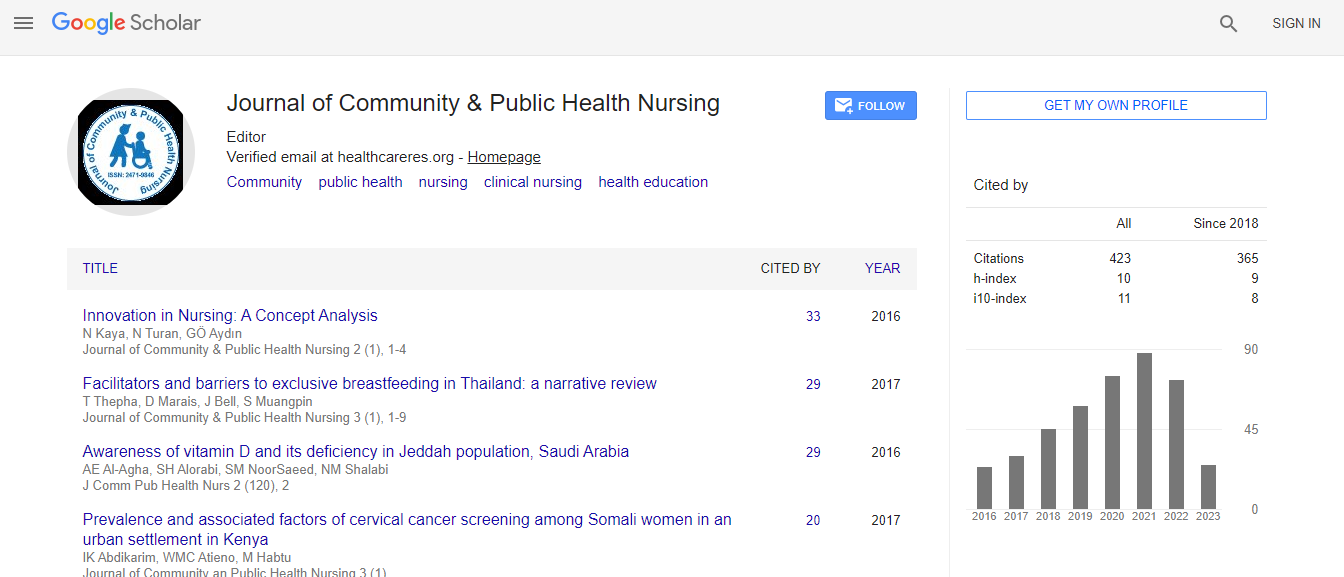Our Group organises 3000+ Global Conferenceseries Events every year across USA, Europe & Asia with support from 1000 more scientific Societies and Publishes 700+ Open Access Journals which contains over 50000 eminent personalities, reputed scientists as editorial board members.
Open Access Journals gaining more Readers and Citations
700 Journals and 15,000,000 Readers Each Journal is getting 25,000+ Readers
Google Scholar citation report
Citations : 739
Journal of Community & Public Health Nursing received 739 citations as per Google Scholar report
Journal of Community & Public Health Nursing peer review process verified at publons
Indexed In
- Google Scholar
- CiteFactor
- RefSeek
- Hamdard University
- EBSCO A-Z
- OCLC- WorldCat
- Publons
- Geneva Foundation for Medical Education and Research
- ICMJE
Useful Links
Recommended Journals
Related Subjects
Share This Page
The uncertainty regarding at bladder training through clamping ├?┬?├?┬▒ndwelling urinary catheters before from removal
7th World Congress on Nursing Education & Research & 39th Global Nursing Care & Patient Safety
Hulya KOCYIGIT
Sivas Cumhuriyet University, Turkey
Keynote: J Comm Pub Health Nurs
Abstract
Nurses are key professionals in the prevention of complications associated with indwelling urinary catheterization in the hospital setting. In this context, bladder training through catheter clamping is an important nursing practice. Indwelling catheter clamping in bladder training was first proposed by Ross in 1936. There is no clear information and sufficient evidence for catheter clamping in bladder training before urinary catheter removal in national and international guidelines for clinical practice. In a study by Williamson (1982) on this subject, it was reported that intermittent clamping before removal of the indwelling urinary catheter reduces the frequency of urinary retention and shortens the time to return to normal bladder function. However, a systematic review published in Cochrane (2007) on strategies for removal of short-term indwelling urethral catheters in adults found insufficient evidence to suggest that catheter clamping prior to termination of catheterization is effective to induce normal bladder filling. In another systematic review published in Cochrane (2016), there was no significant difference between the patients' subjective perceptions of recatheterization, urinary retention, catheter-related urinary tract infection and urination symptoms in the clamping and free drainage groups. In the limited number of studies on bladder training performed by clamping the indwelling urinary catheter, no evidence for practice could be obtained, and there is no consensus among clinicians yet. Ultimately, more research, better quality methodology, and more diverse study designs are needed until strong evidence is available to remove this uncertainty. Keywords: Clamping, Indwelling Urinary Catheters, NursingBiography
Hulya Kocyigit is currently working as Research Assistant at the Universty of Sivas Cumhuriyet, Turkey. She graduated from the Department of Nursing, Faculty of Health Sciences at the Universty of Sivas Cumhuriyet in 2015. She graduated a Master’s degree in from the Department of Fundamentals of Nursing at the Universty of Sivas Cumhuriyet in 2018. She has currently been a PhD student in the Department of Nursing at the Universty of Sivas Cumhuriyet since 2019.

 Spanish
Spanish  Chinese
Chinese  Russian
Russian  German
German  French
French  Japanese
Japanese  Portuguese
Portuguese  Hindi
Hindi 
